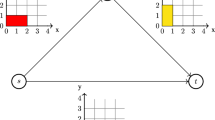Abstract
It is well-known how to use maximum flow to decide when a flow problem with demands, lower bounds, and upper bounds is infeasible. Less well-known is how to compute a flow that is least infeasible. This paper considers many possible ways to define “least infeasible” and shows how to compute optimal flows for each definition. For each definition it also gives a dual characterization in terms of cuts, a polynomial routine for recognizing that type of least infeasible flow, and relates that definition to dual cut canceling min-cost flow network algorithms.
Similar content being viewed by others
References
C. Aggarwal, J. Hao and J.B. Orlin, Diagnosing infeasibilities in network flow problems, MIT Sloan School Working Paper WP # 3696, Cambridge, MA, 1994.
R.K. Ahuja, A.V. Goldberg, J.B. Orlin and R.E. Tarjan, Finding minimum-cost flows by double scaling,Math. Programming 53 (1992) 243–266.
R.K. Ahuja, T.L. Magnanti and J.B. Orlin,Network Flows: Theory, Algorithms and Applications (Prentice Hall, New York, NY, 1993).
F. Barahona and É. Tardos, Note on Weintraub’s minimum cost flow algorithm,SIAM J. Comput. 18 (1989) 579–583.
R. Bellman, On a routing problem,Quarterly of Applied Mathematics 16 (1958) 87–90.
T.R. Ervolina and S.T. McCormick, Two strongly polynomial cut cancelling algorithms for minimum cost network flow,Discrete Applied Mathematics 46 (1993) 133–165.
T.R. Ervolina and S.T. McCormick, Cancelling most helpful total cuts for minimum cost network flow,Networks 23 (1993) 41–52.
A. Frank and A.V. Karzanov, Determining the distance to the perfect matching polytope of a bipartite graph, Technical Report RR 895-M, Laboratoire ARTEMIS IMAG, Université Joseph Fourier, Grenoble, France, 1992.
S. Fujishige, Lexicographically optimal base of a polymatroid with respect to a weight vector,Math. of OR 5 (1980) 186–196.
S. Fujishige, Submodular functions and optimization,Annals of Discrete Mathematics, Vol. 47 (North-Holland, Amsterdam, 1991).
G. Gallo, M.D. Grigoriadis and R.E. Tarjan, A fast parametric maximum-flow algorithm and applications,SIAM J. Comput. 18 (1989) 30–55.
A.V Goldberg, Scaling algorithms for the shortest paths problem, Stanford University Computer Science technical report STAN-CS-92-1429, Stanford, CA, 1992.
A.V. Goldberg and R.E. Tarjan, Solving minimum cost flow problems by successive approximation,Math. of OR 15 (1990) 430–466.
H.J. Greenberg, Diagnosing infeasibility in min-cost network flow problems Part I: Dual infeasibility,IMA J. of Math. in Management 1 (1987) 99–109.
H.J. Greenberg, Diagnosing infeasibility in min-cost network flow problems Part II: Primal infeasibility,IMA J. of Math. Applied in Business & Industry 2 (1988/9) 39–50.
H.J. Greenberg, Consistency, redundancy, and implied equalities in linear systems, Technical Report, Math. Dept., U. of Colorado at Denver, Denver, CO, 1993; to appear inAnnals of Mathematics and Artificial Intelligence.
R. Hassin, The minimum cost flow problem: A unifying approach to dual algorithms and a new tree-search algorithm,Math. Prog. 25 (1983) 228–239.
R. Hassin, Algorithms for the minimum cost circulation problem based on maximizing the mean improvement,OR Letters 12 (1992) 227–233.
A.J. Hoffman, Some recent applications of the theory of linear inequalities to extremal combinatorial analysis, in: R. Bellman and M. Hall, Jr., eds.,Proceedings of Symposia in Applied Mathematics, Vol. X, Combinatorial Analysis (American Mathematical Society, Providence, RI, 1960) 113–127.
K. Iwano, S. Misono, S. Tezuka and S. Fujishige, A new scaling algorithm for the maximum mean cut problem,Algorithmica (1994) 11 243–255.
A.V. Karzanov and S.T. McCormick, Polynomial methods for separable convex optimization in totally unimodular linear spaces with applications to circulations and co-circulations in networks, Technical Report RR 927 -M-, Laboratoire ARTEMIS IMAG, Université Joseph Fourier, Grenoble, France, 1993. To appear in:SIAM J. on Computing; extended abstract inProceedings of the Sixth SODA (1995), 78–87.
S.T. McCormick and T.R. Ervolina, Computing maximum mean cuts,Discrete Applied Mathematics 52 (1994) 53–70.
S.T. McCormick, Approximate binary search algorithms for mean cuts and cycles,OR Letters 14 (1993) 129–132.
T. Radzik, Minimizing capacity violations in a transshipment network,Proceedings of the Third Annual ACM-SIAM Symposium on Discrete Algorithms (1992) 185–194.
T. Radzik, Newton’s method for fractional combinatorial optimization,Proc. 33rd IEEE Annual Symp. of Foundations of Computer Science (1992) 659–669; see also Parametric flows, weighted means of cuts, and fractional combinatorial optimization in:Complexity in Numerical Optimization, ed. P. Pardalos (World Scientific, 1993) 351–386.
G. Rote, An improved time bound for computing maximum mean cuts, Talk given at 14th International Symposium on Mathematical Programming, Amsterdam, The Netherlands, 5–9 August 1991.
M.H. Schneider, Max-balanced flows,Proceedings of IPCO 1991, Waterloo, ON, 1990, pp. 421–429.
A. Weintraub, A primal algorithm to solve network flow problems with convex costs,Man. Sci. 21 (1974) 87–97.
N.E. Young, R.E. Tarjan and J.B. Orlin, Faster parametric shortest path and minimum balance algorithms,Networks 21 (1991) 205–221.
Author information
Authors and Affiliations
Additional information
This research was partially supported by an NSERC Operating Grant, an NSERC Grant for Research Abroad, and a UBC Killam Faculty Study Leave Fellowship. Parts of this research were done while the author was visiting Laboratoire ARTEMIS IMAG at Université Joseph Fourier de Grenoble, France.
Rights and permissions
About this article
Cite this article
McCormick, S.T. How to compute least infeasible flows. Mathematical Programming 78, 179–194 (1997). https://doi.org/10.1007/BF02614370
Received:
Revised:
Issue Date:
DOI: https://doi.org/10.1007/BF02614370



